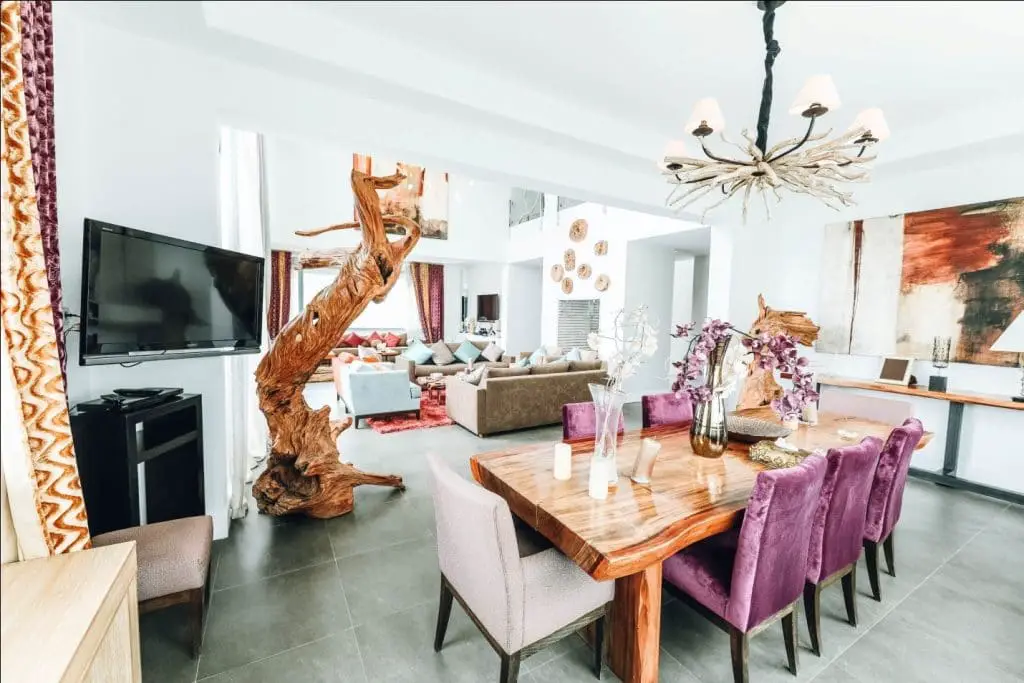Rugs are an integral interior design element that can instantly elevate the appearance and ambiance of a room. Since rugs look great in almost all areas of your home, you may be wondering if they’ll bode well in your dining room, too.
Should You Have a Rug in the Dining Room?
Most people face the dilemma of laying down a rug in the dining room – for fear of it getting weighed down with spills and crumbs. Well, there’s no need to be scared. A well-chosen rug is the perfect solution to elevate dining room décor and visual appearance to create a wonderful and welcoming ambiance. The benefits of having a rug in your dining room outweigh all the drawbacks downright.
Why Should You Have a Rug in the Dining Room?
Here are a few reasons to add a rug in the dining room:
To Define Boundaries
Certain homes, especially loft-style apartments, don’t have a distinct or set space for a dining room. So, the dining table and chairs often float around between the living room, kitchen, or entryway. Installing a modern dining room rug can help you create your own proper, well-laid-out dining area. Establish a dining area boundary in a large neutral home by using a rug with eye-catching color and pattern.
To Add a Pop of Color
Most people choose to keep their dining rooms plain and neutral, which often leads them to look like they lack something. Opt for a bold and vibrant-colored rug to place under a dining table and chairs to break up the existing monotony of neutrals in a room. A fierce-colored shag rug pairs impeccably with earth-toned tables and chairs.
To Make Things Cozy
Rugs provide you the ultimate place to sink your bare feet comfortably. These interior design elements help cover up cold floors and add lots of aesthetic appeal through their wonderful texture, transforming your dining room into a cozy and inviting space. An important thing to remember is that although texture is excellent, it is preferable to opt for low-pile rugs for the dining room. That’s because thick, furry, and shaggy rugs can hold on to dirt and debris for longer.
Read Also: How to Maximize Your Dining Room Layout
For a More Cohesive Look
Make sure to pick a rug with clever and interesting patterns and accent notes that match well with the colors and details of your dining table set. Your rug can have the same texture, color, or style as your furniture, or it should complement and accent your dining set, serving as a visual centerpiece. Either way, you should choose a rug that bodes well with room or dining set’s shape.
To Create Movement
Neutral colors can often stall energy and dampen the movement of a room. Add a rug with stimulating patterns, colors, and designs can help create movement, making your dining room more welcoming. After all, you would want to dine in a space that feels static and monotonous.
To Add Personality
There’s nothing wrong with choosing to keep your dining room’s floor bare. Whether it is tiled, carpeted, or is made with hardwood, it is alright to want to show off your floor. However, like your walls, your floors need some personality too, and adding a rug might just be the very move that will help inject a sense of personality into your dining room. Your guests can comfortably sink their bare feet in your plush rug, allowing them to enjoy their meal even more.
How to Choose a Rug for a Dining Room?
You need to be a little careful when choosing a rug for your dining room. It’s best to opt for a low pile or flat weave rug as it will be easier to clean in case of inevitable spills. As good as a textured shag rug with long hoops looks, it doesn’t offer the same level of practicality as a flat weave or low pile rug. Another major consideration is size. You need to select a dining room rug that’s big enough to accommodate your table and chairs.
How to Place a Rug in a Dining Room?
The ideal area to place a rug is right at the center under the dining table and chairs, with all the table’s legs and chairs fitting perfectly atop the rug. You also need to ensure that the placement of the rug doesn’t interfere with a guest pulling of their chair, nor should the chair’s legs end up outside the rug when seated.
What Size Rug do I Buy for My Dining Room?
Generally, your area rug should extend a minimum of 24-inches on all sides if you have a 6-seater dining table. However, the size of the rug corresponds to the size of your dining table. In any case, a rug should extend beyond the dining table’s borders.
How to Keep a Dining Room Rug Clean?
A rug’s maintenance will depend on the overall footfall of the space. So, if your dining room is used regularly, you will have to vacuum and sweep it daily to get rid of any crumbs and debris left behind. When necessary, apply a cleaner immediately to remove stains the moment they occur. Moreover, remember to give your rug thorough shampooing on a quarterly basis, allowing it to dry completely before returning it to its respective space. If you feel like you can’t handle the stain of a rug by yourself, call in cleaning professionals.
Conclusion
Whether or not you should have a rug in the dining room is totally up to you. Although it isn’t mandatory to set up a rug underneath your dining table and chairs, it is an excellent display of tasteful décor. Rugs bring a space together by adding personality, color, coziness and establishing a greater sense of warmth, security, and comfort during a meal. Sure, there’s always a risk of spills, but you can have easily have them cleaned. So, to conclude, install a rug in your dining room today and see the difference it makes!



